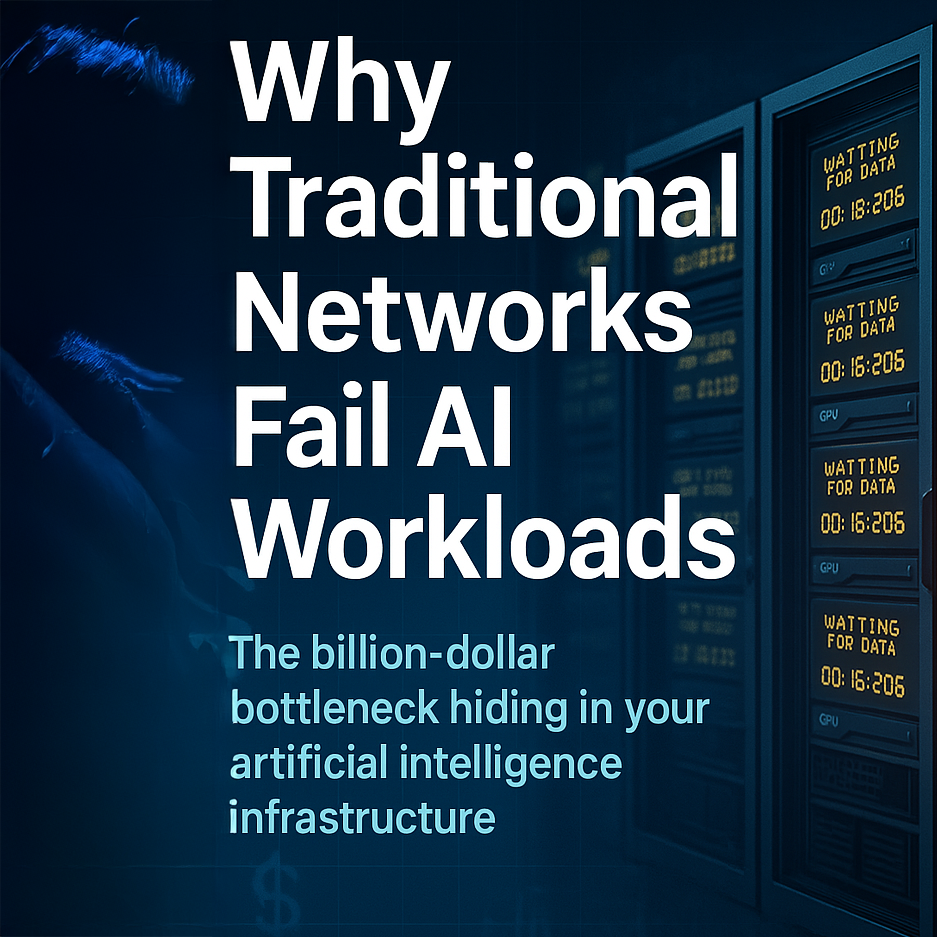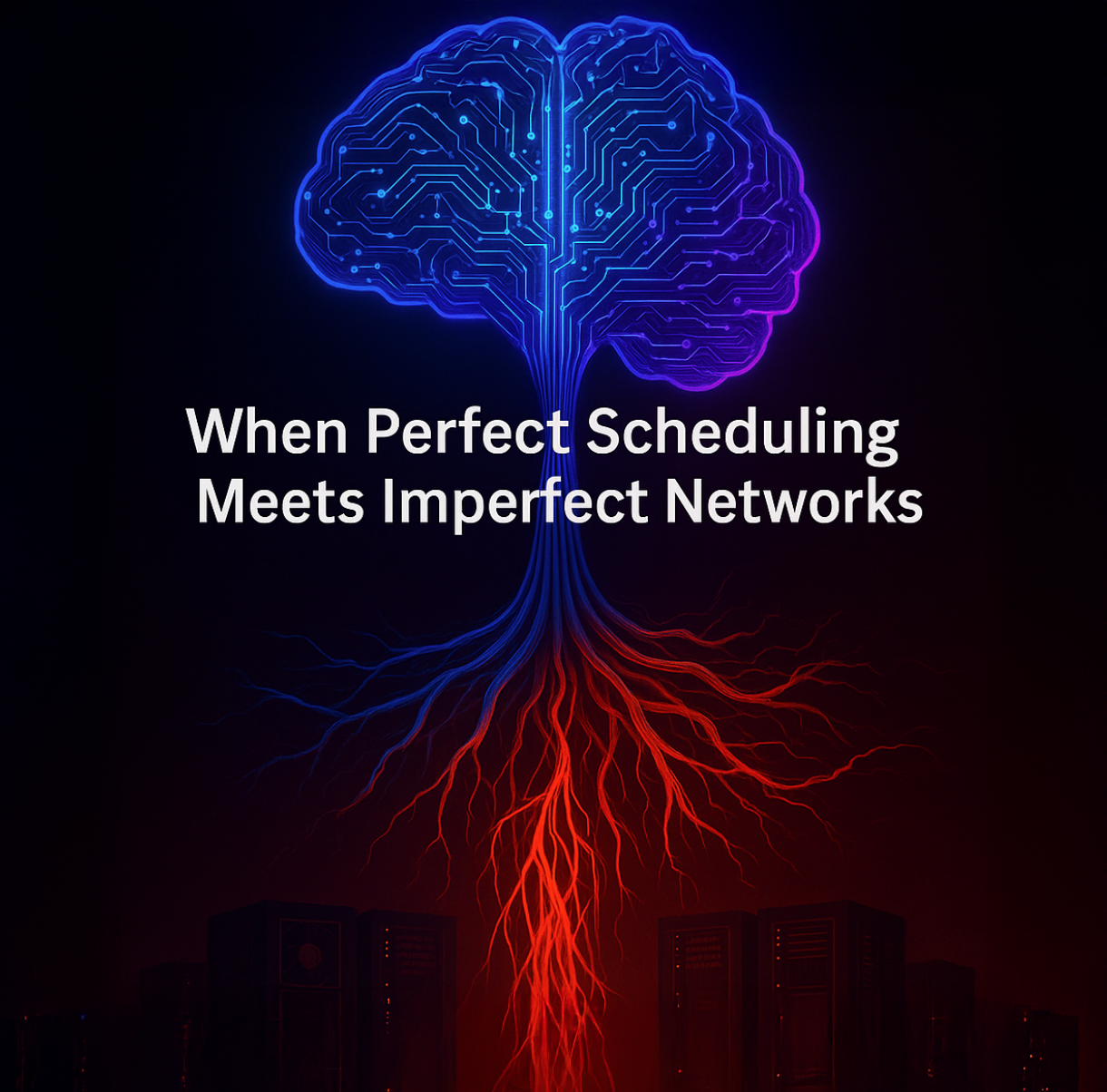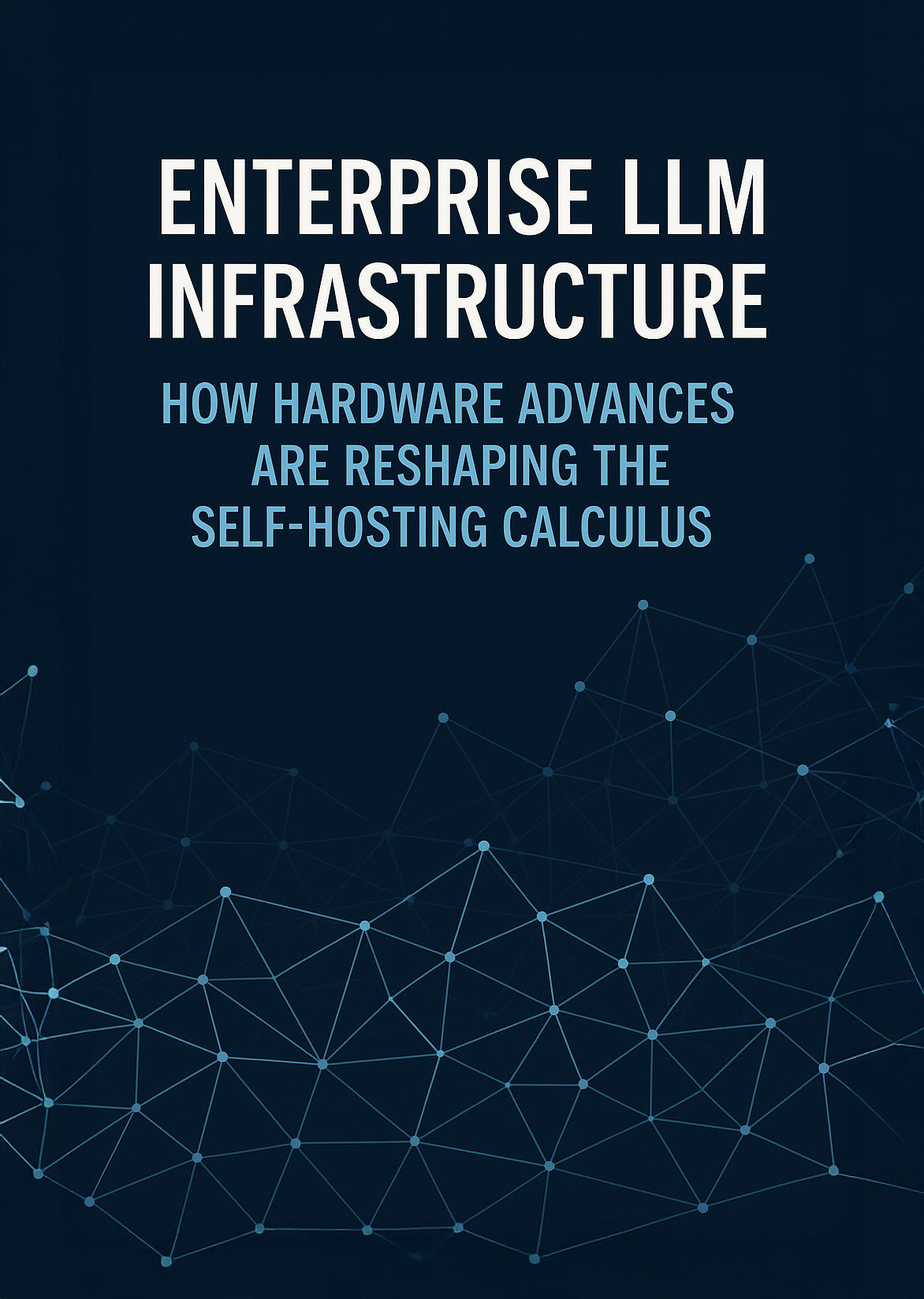Why Traditional Networks Fail AI Workloads
Why Traditional Networks Fail AI Workloads The billion-dollar bottleneck hiding in your artificial intelligence infrastructure
9 min read
![]() Art Fewell
:
Jun 26, 2025 2:19:19 PM
Art Fewell
:
Jun 26, 2025 2:19:19 PM

If you work with AI infrastructure, build applications with large language models, or fine-tune models for your organization, you've probably heard the term "collective communications" thrown around in technical discussions. It sounds important, but what does it actually mean? And why do AI engineers get so concerned about it when scaling machine learning training to multiple GPUs?
The short answer is that collective communications are the coordination mechanisms that allow hundreds or thousands of GPUs to work together on training a single machine learning model. But understanding why this coordination is necessary, how it actually works, and why it creates unique challenges requires starting with a more fundamental question: how do you actually split up the work of training a large language model across multiple GPUs in the first place?
To understand collective communications, we first need to understand the problem they solve. When you're training a large language model, you're essentially teaching the machine learning model to predict the next word in a sequence by showing it millions of examples. The model learns by gradually adjusting millions or billions of parameters based on how well it performs on each example.
Here's the challenge: modern language models are enormous. GPT-4 has trillions of parameters, and the latest models continue to grow at a significant pace. A single GPU, even the most powerful ones available today, simply doesn't have enough memory to hold all these parameters plus the high-quality training data needed for effective learning. So you need to split the work across multiple GPUs.
There are several ways to do this splitting, but the most common approach for large-scale training is called data parallelism. Think of it like this: instead of having one GPU look at all your training data sequentially, you give different batches of training data to different GPUs, but each GPU has a complete copy of the model.
Let's use a concrete example. Imagine you're training a model and you have 1,000 examples to learn from. With data parallelism across 10 GPUs:
GPU 1 gets examples 1-100
GPU 2 gets examples 101-200
GPU 3 gets examples 201-300
And so on...
Each GPU processes its batch of examples and calculates how the model should be updated based on what it learned from those examples. These updates are called gradients - they're essentially mathematical instructions for how to adjust each parameter in the model to make it perform better.
But here's the crucial part: even though each GPU worked on different examples, they all need to end up with the same updated model at the end. If GPU 1 learns one thing from its examples and GPU 2 learns something different, those learnings need to be combined so all GPUs have the same improved model for the next round of training.
This is where collective communications come in.
After each GPU finishes processing its batch of training examples, you have a synchronization problem. Each GPU has calculated gradients based on its specific examples, but to update the model properly, you need to combine the learning from all GPUs.
The most common way to handle this is through an operation called all-reduce. In simple terms, all-reduce takes the gradients calculated by each GPU, adds them together, and gives every GPU the same combined result. It's like taking test scores from 10 different classrooms, calculating the average, and then giving that average to every teacher so they all have the same information about overall performance.
This might sound straightforward, but it becomes complex very quickly when you scale up. If you have 1,000 GPUs, each with gradient data that might be several gigabytes in size, you need to combine all that data and distribute the result back to every GPU. And this needs to happen fast - those expensive GPUs are sitting idle until the synchronization completes.
The mathematics are unforgiving. Each GPU might have gradient arrays containing millions of values. During all-reduce, every value from every GPU needs to be combined with the corresponding values from every other GPU. If you have 1,000 GPUs each contributing 1 million gradient values, you're looking at combining 1 billion individual pieces of data and ensuring every GPU gets the complete result.
All-reduce is the most common collective operation, but it's not the only one. Understanding the full toolkit helps explain why these operations create such demanding requirements for network infrastructure.
Broadcast is simpler conceptually - one GPU (often called the "root") sends the same data to all other GPUs. This happens when you need to distribute updated model parameters or configuration information to all workers. The challenge is that the sending GPU becomes a bottleneck, as it needs to transmit the same large dataset to potentially thousands of receivers simultaneously.
All-gather is where each GPU contributes a unique piece of data, and every GPU ends up with everyone else's contribution. Imagine each GPU processing a different chapter of a book, and at the end, every GPU needs a copy of the complete book. Each GPU contributes its chapter and receives all the other chapters from other GPUs.
All-to-all represents the most challenging communication pattern. Here, every GPU has unique data that needs to go to every other GPU, but unlike all-gather, each piece of data goes to a specific destination. It's like a massive mail sorting operation where every GPU is both sending unique letters to every other GPU and receiving unique letters from every other GPU.
The bandwidth requirements for all-to-all are staggering. If you have N GPUs, you need N² unique data transfers. With 1,000 GPUs, that's 1 million individual data transfers happening simultaneously. Even with perfect network infrastructure, the receiving GPUs face an impossible situation - hundreds of high-bandwidth streams all trying to reach the same destination at the same time.
This is where networking becomes relevant to understanding collective communications. Traditional enterprise networks were designed around very different assumptions about traffic patterns. Most business applications generate relatively random, distributed traffic where individual connections are modest in bandwidth and timing flexibility exists.
Collective communications create the exact opposite: massive bandwidth demands with strict timing requirements and highly synchronized traffic patterns. When 1,000 GPUs simultaneously begin an all-reduce operation, they create synchronized traffic bursts that can overwhelm network infrastructure designed for statistical load distribution.
Consider what happens during a typical all-reduce operation. For a brief moment, the network is relatively quiet. Then, suddenly, every GPU begins transmitting gradient data to multiple destinations simultaneously. This creates what network engineers call "incast" scenarios - multiple high-bandwidth senders targeting the same receiver, causing temporary bandwidth oversubscription that can overwhelm switching hardware.
Traditional implementations of Equal-Cost Multi-Path (ECMP) routing can make this worse. ECMP itself remains relevant for AI networks, but the hash-based algorithms that ECMP has historically used create problems for collective communications. When many flows share similar characteristics (as they do during collective operations), traditional hash functions cause multiple high-bandwidth streams to compete for the same network path while other paths remain idle.
This is why companies like Meta have developed custom ECMP algorithms optimized for AI traffic patterns, and why Broadcom has introduced adaptive routing capabilities in their Cognitive Routing suites. These enhanced ECMP implementations use different path selection algorithms that can handle the synchronized traffic patterns of collective communications more effectively than traditional approaches.
The timing sensitivity makes these challenges even more difficult. Unlike traditional applications that can tolerate variable network latency, distributed training requires predictable, low-latency communication to keep expensive GPU hardware fully utilized. When network congestion causes delays in collective operations, the entire training job stalls while thousands of GPUs wait for the communication to complete.
The AI infrastructure community has developed sophisticated algorithms to manage these communication challenges effectively. Understanding these approaches helps explain why collective communications work the way they do and why they create specific demands on network infrastructure.
Ring algorithms arrange GPUs in a logical ring topology where each GPU communicates only with its immediate neighbors. During all-reduce, gradients are passed around the ring in a systematic pattern that ensures every GPU eventually receives contributions from every other GPU. Ring algorithms provide excellent bandwidth utilization because every network link carries useful data throughout the operation.
However, ring algorithms have a latency problem. The time to complete an all-reduce operation scales linearly with the number of GPUs - adding more GPUs directly increases the time required to complete the communication. For small clusters, this isn't problematic, but when scaling to thousands of GPUs, the linear latency scaling becomes a significant bottleneck.
Tree algorithms arrange GPUs in a hierarchical tree structure that enables logarithmic scaling - doubling the number of GPUs only adds one additional "hop" to the communication time. NVIDIA's NCCL library implements sophisticated tree algorithms that can provide dramatic latency improvements at large scales, with testing showing up to 180x better performance compared to ring algorithms when scaling to tens of thousands of GPUs.
The tradeoff is bandwidth efficiency. Tree algorithms typically achieve their superior latency by using only about half of the available network bandwidth compared to ring algorithms. They optimize for speed rather than maximum utilization of network resources.
This might seem contradictory - if AI training overwhelms networks, how can algorithms that use less bandwidth be better? The answer is that the "overwhelming" problem isn't usually about total bandwidth utilization. It's about the bursty, synchronized nature of AI traffic and specific bottlenecks like incast scenarios. Tree algorithms reduce these problematic traffic patterns by completing collective operations much faster, even though they don't maximize theoretical bandwidth usage. A tree algorithm that uses 50% of available bandwidth but completes in microseconds often delivers better overall performance than a ring algorithm that uses 90% of bandwidth but takes much longer to finish.
Hierarchical algorithms attempt to get the best of both approaches by implementing two-dimensional communication patterns. These algorithms first perform collective operations within local groups of GPUs (like 8 GPUs connected by high-speed NVLink within a single server), then perform higher-level collective operations between groups over the network fabric.
This approach can dramatically reduce network traffic because much of the communication happens over very fast local connections rather than the network. But it requires careful coordination between the logical communication topology and the physical hardware design.
Understanding these communication patterns matters because they directly impact both performance and costs in real AI deployments. When collective communications are inefficient, expensive GPU hardware sits idle waiting for data, turning infrastructure investments into operational waste.
Recent performance results illustrate the impact. NVIDIA's Blackwell B200 GPUs can deliver 9 PFLOPS of computing performance, but that performance is only achievable when collective communications can keep pace with the computational demands. In large-scale training runs, poorly optimized collective communications can cause GPUs to spend 70% of their time waiting for network operations to complete.
The economic implications are substantial. Consider a training cluster that costs $10 million to operate. If collective communication inefficiencies cause AI training jobs to take twice as long to complete, you've essentially doubled your infrastructure costs. At the scale of major AI companies, these inefficiencies can represent hundreds of millions of dollars in wasted resources annually.
This is why organizations like Meta, Google, and Microsoft invest so heavily in optimizing their networking infrastructure for artificial intelligence workloads. It's not just about having fast networks - it's about having networks that can handle the specific, demanding communication patterns that distributed training creates.
The networking industry has responded to these challenges with infrastructure specifically designed for AI workloads. The recently released Ultra Ethernet 1.0 specification represents the most significant advancement in this space, providing standardized approaches to handling collective communication patterns efficiently.
Ultra Ethernet introduces several innovations specifically targeted at collective communications. The Ultra Ethernet Transport (UET) protocol implements ephemeral connections that eliminate the handshake delays traditional networking protocols require before data transmission begins. This is crucial for collective operations that need to start and stop rapidly.
Perhaps most importantly, Ultra Ethernet includes standardized support for In-Network Collectives (INCs), where network switches can participate directly in collective operations rather than simply forwarding packets. This allows network infrastructure to actively assist with operations like all-reduce, performing some of the mathematical operations directly in the network hardware rather than requiring GPUs to handle all the computation.
These advances are enabling new levels of efficiency in distributed training. Organizations deploying Ultra Ethernet-compliant infrastructure are seeing significant improvements in collective communication performance while maintaining the cost advantages and vendor flexibility that Ethernet provides.
If you're responsible for AI infrastructure, application development, or model training, understanding collective communications helps you make better decisions about hardware, software, and operational strategies.
For Infrastructure Planning: Collective communication requirements should influence network topology decisions. Traditional enterprise network designs may create bottlenecks for AI workloads even when they provide adequate bandwidth for other applications. Consider how your network fabric will handle synchronized, high-bandwidth traffic patterns when evaluating infrastructure options. The operational complexity of implementing these AI-optimized networking configurations often requires specialized computer science expertise that many organizations don't have in-house. This challenge has led Hedgehog to develop solutions that automate AI networking optimizations and provide cloud-like operational experiences, enabling teams to deploy high-performance AI networks without requiring specialized networking expertise.
For AI Model Training: Understanding collective communications helps explain why some training configurations perform better than others. The relationship between batch sizes, GPU counts, and model architectures affects collective communication patterns, which in turn impacts training efficiency and cost. This applies whether you're working with generative AI models, chatbots, or other AI applications that require extensive data annotation and training processes.
For AI Development: Even if you're building applications that use pre-trained models via APIs, understanding collective communications provides insight into the infrastructure requirements behind those APIs. This knowledge helps with capacity planning, cost modeling, and understanding the technical constraints that affect model availability and pricing.
For Technology Evaluation: When evaluating AI frameworks, hardware platforms, or cloud services, collective communication capabilities often differentiate solutions that appear similar on paper. Understanding these patterns helps you ask better questions and identify potential performance bottlenecks before they impact your projects.
Collective communications will become even more important as the future of AI continues to evolve with increasingly large models. The latest generations of GPUs provide extraordinary computational capabilities, but realizing that potential requires network infrastructure that can handle increasingly demanding collective communication patterns.
AMD's MI325X accelerators and NVIDIA's Blackwell architecture represent significant advances in processing power, but they also create new challenges for collective communications. More powerful GPUs generate larger gradient arrays that need to be synchronized more frequently, placing even greater demands on network infrastructure.
The industry is exploring next-generation approaches including optical interconnects, disaggregated memory architectures, and new collective communication algorithms optimized for cutting-edge hardware capabilities. But regardless of which specific technologies become dominant, the fundamental challenge remains: coordinating the work of thousands of processors working together on the same computational task.
Organizations that understand collective communications and design their AI systems accordingly will have significant advantages as AI workloads become increasingly central to business operations. The companies succeeding in AI aren't necessarily those with the biggest hardware budgets - they're those that understand how to make all the pieces work together effectively.
Understanding collective communications gives you the foundation to participate in these technical discussions confidently, make informed infrastructure decisions, and anticipate the challenges that matter most for AI success. Whether you're fine-tuning models, building AI applications, working in data science, or designing the infrastructure that makes it all possible, collective communications are the coordination mechanisms that enable everything else to work.
If you found this exploration of collective communications helpful and want to see how these concepts translate into practical networking solutions, Hedgehog's open source approach makes it easy to explore AI-optimized networking firsthand. You can try our virtual lab environment on your own machine to experience how modern AI networking can work without the operational complexity.

Why Traditional Networks Fail AI Workloads The billion-dollar bottleneck hiding in your artificial intelligence infrastructure

Why Your Advanced Kubernetes AI Scheduler Might Be Fighting a Losing Battle If you work with AI infrastructure, manage Kubernetes clusters for...

Cohere's recent $6.8 billion valuation signals something interesting about enterprise AI preferences, but not quite what you might expect. While...